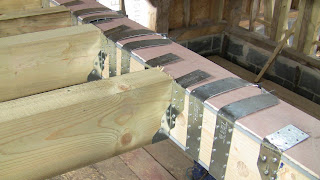Talking of charm and character, where else would you see a diagonal stud right across doorway?
As described previously, here's a steel beam with nog insert and joist hangers nailed into it
And first floor joists resting on Stonehenge resting on the sole plate on the plinth. Interesting load paths here. (Another term I picked up recently - load path. How the load of the first floor, in this case, gets transferred down through the structure. Ultimately it reaches the foundation and we don't care about it after that. There's probably some poor guy in Australia holding it all up.)
Alternative load path - joists hanging off a beam which at one end is bearing on a block wall. The blocks are individually quite weak with a crushing strength of about 3.5 Newtons, whatever they are. (Something to do with apples I believe.) So the point where the beam rests on the wall is made up of engineering bricks to take, and spread, the load.
Just looked it up - a Newton is the force required to increase the speed of a 1kg mass by 1m per second, per second. Clear as mud? Apparently it's approximately the force needed to hold up a 100g weight, ie an apple. Curious eh? So I can see why you need engineering bricks to hold up a steel beam. Obviously a bunch of engineers is going to be stronger than 3 and a half apples. Obvious or what?
They've started to build a bedroom wall upstairs, under one of the trusses. The truss will be visible from both bedrooms either side of the wall.
The bits and bobs for the flue have arrived
A bressumer over the fireplace. It's cut from one of the beams taken from another part of the barn. (Found a use for it.) It's elm, apparently. Had it sandblasted and treated. Come up lovely hasn't it? There's also one on the other side of the fireplace, cut from the same old beam.
I'd never heard of bressumers before. (And me a born-again country bumpkin. Whatever next?) Anyway, Wikipedia, the fount of all knowledge (some of it a bit dodgy) says a bressummer, or breastsummer, is a beam. Hmm, tells me a lot. Elsewhere on t'internet I've found that the word comes from the french sommier, meaning beam, and is a kind of lintel, ie a beam spanning an opening below it and supporting some structure above it. Like the mantle over a fireplace? The difference between a lintel and a bressummer is that a lintel would be used where there's a door or window in the space below, implying that the lintel mustn't flex in the middle, whereas a bressummer spans an open space (like a fireplace!) where it doesn't matter if the beam flexes a bit. And if you believe that you'll believe anything because if, for example you've got a brick panel above the opening it has to be supported by something that doesn't flex, otherwise you'd have bricks falling on your head as you poke the fire. Not good, unless you don't mind wearing a hard hat indoors.
I'd never heard of bressumers before. (And me a born-again country bumpkin. Whatever next?) Anyway, Wikipedia, the fount of all knowledge (some of it a bit dodgy) says a bressummer, or breastsummer, is a beam. Hmm, tells me a lot. Elsewhere on t'internet I've found that the word comes from the french sommier, meaning beam, and is a kind of lintel, ie a beam spanning an opening below it and supporting some structure above it. Like the mantle over a fireplace? The difference between a lintel and a bressummer is that a lintel would be used where there's a door or window in the space below, implying that the lintel mustn't flex in the middle, whereas a bressummer spans an open space (like a fireplace!) where it doesn't matter if the beam flexes a bit. And if you believe that you'll believe anything because if, for example you've got a brick panel above the opening it has to be supported by something that doesn't flex, otherwise you'd have bricks falling on your head as you poke the fire. Not good, unless you don't mind wearing a hard hat indoors.
The engineer has insisted that the bressummers be protected from the loading of the brickwork above . So maybe there's some truth to the bit about bressummers and flexing in the middle. So we had to scour the region for the right size of lintel, a catnic steel lintel, the edge of which which is just visible above the bressemer.
You can tell it's an elm bressummer by the pigeon-breast pattern on the surface, so they tell me. It's also riddled with woodworm - now treated and full of character. Or should that be characters? (Poor little woodworms - going about the business of being a woodworm and along comes a nasty property developer ...)
The fireplace is going up
... and the flue is going up the chimney
Here you can see how the catnic lintel overlaps, and is bearing on, the exterior skin of bricks so that the load of the brickwork above the lintel, ie above the bressummer, is transferred to the side brick pillars. Clever load path huh?
Up on the roof the gutters are being fixed to the fascia boards
And the first batch of window frames has been delivered. All bespoke and not a standard off the shelf item to be seen. We opted for Douglas fir as a compromise between softwood and oak. Once they're painted and installed we'll get the glaziers to come and measure up.
And finally











































